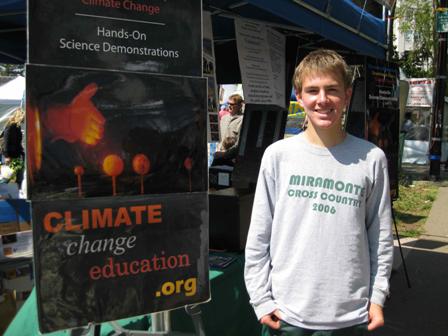
Devin Finzer is a 2008 California Climate Champion from Orinda who graduated from Miramonte High School in June. In this guest post for the Climate Watch blog, he describes how he and fellow Champion Patrick Ouziel were able to start a carpooling program at his school.
Walking to my high school each morning, I trekked past long lines of backed-up traffic. Driver after driver waited anxiously for his or her chance to round the corner into the Miramonte High School lot and hunt for a coveted parking spot. For the most part, each car contained just one person. The passenger seats of large SUVs and mini-vans were often left completely empty. The early-morning situation involved stress, traffic congestion, and unnecessary pollution. Fellow student Patrick Ouziel and I decided we could do something about it.
As California Climate Champions sponsored by the California Air Resources Board and the British Council, Patrick and I are engaged in local and international efforts to take action and spread awareness about climate change. One of the main environmental issues we noticed at our high school was the way students get around. With after-school sports and club activities, juniors and seniors take advantage of their newly earned driver’s license, but by driving only themselves, they often missed out on easy, cost-beneficial, and eco-friendly ways to group together with other students traveling their same route.
Patrick and I are proud to have lobbied for the expansion of our school’s carpool system, which provides carpoolers with designated parking spots each morning. During the school year, we produced several videos promoting eco-friendly transportation and climate awareness, and linked these videos to a web site where students could demonstrate their support for increasing the percentage of carpool spots at our school. We also provided an option where students could sign up as “potential carpoolers” in order to find other ride-sharers who lived close by.
The result? With the support of students and the administration, we transformed our parking lot reserved for high school seniors into a lot exclusively for carpoolers. Now 80 spots, about 30% of our entire lot, are reserved exclusively for carpoolers.
What are the environmental benefits for the new program? While differing gas mileages and travel distances make exact calculations difficult, we do know that carpooling with just one other person already cuts per-person emissions, as well as gas costs, in half, and we can estimate that our carpool system inspired about 40 additional carpool groups.
While deciding to carpool almost seems almost like a no-brainer, Patrick and I did face significant barriers when we emphasized the importance of ridesharing. From the get-go, one of the main obstacles we had to address was the relationship between driving and teenage independence. Every sixteen-year-old remembers the day he earns his license: the fresh feeling of the driver’s seat and the thrill of taking the wheel, free from parental supervision. Americans clearly love to drive, and apparently, many of us love to do it by ourselves — a 2005 U.S. Census Bureau survey says 77 percent of American workers drive to and from work alone.
In our awareness videos, Patrick and I emphasized that carpooling doesn’t have to be a sacrifice of this independence. Rather, it can be an effective symbol of collaboration: sharing a ride is an opportunity to spend time with friends, or to get to know new people. Teenagers are social beings who feel most content when they are connected with their peers. That’s why we emphasized the importance of a collective carpool movement built on the strong sense of community at our school.
Advocating carpooling can be a great way to start a green movement at your own school or workplace. There are a number of web sites that match potential carpoolers and make ridesharing easy. I’ve reviewed a few of the better-known ride-matching sites on my blog.
Patrick and I will both be going to school on the East Coast next year, Patrick at Yale and myself at Brown. We plan to continue our climate change activism. In particular, I’d like to encourage the installation of solar panels on the roofs of high schools and universities. Our continued environmental efforts will be documented on my blog.
Special thanks to Climate Watch intern Kristine Wong for help with this post.
2 thoughts on “California Climate Champions: Project Carpool”
Comments are closed.

Thanks Devin for all your great work — and for sharing it on the KQED site.
Meg Holmberg
Nice Devin! I hope that your project will inspire others as you’ve already proven that it can significantly reduce emissions for no cost at all.